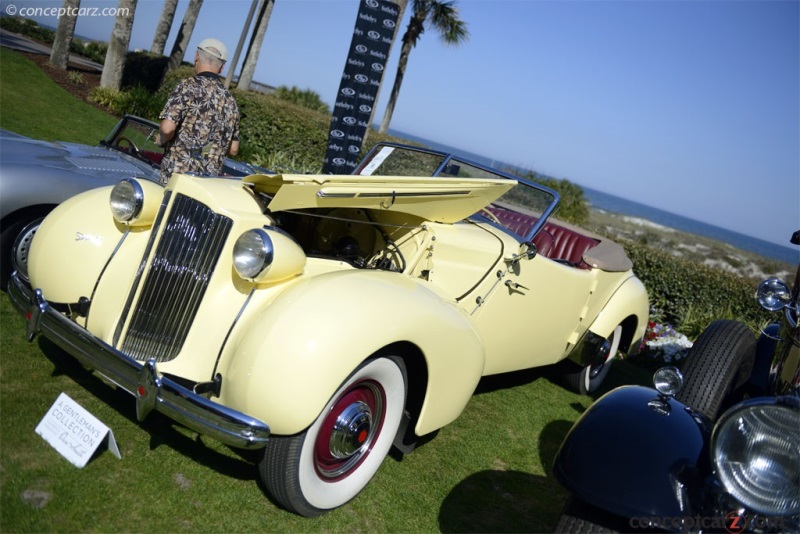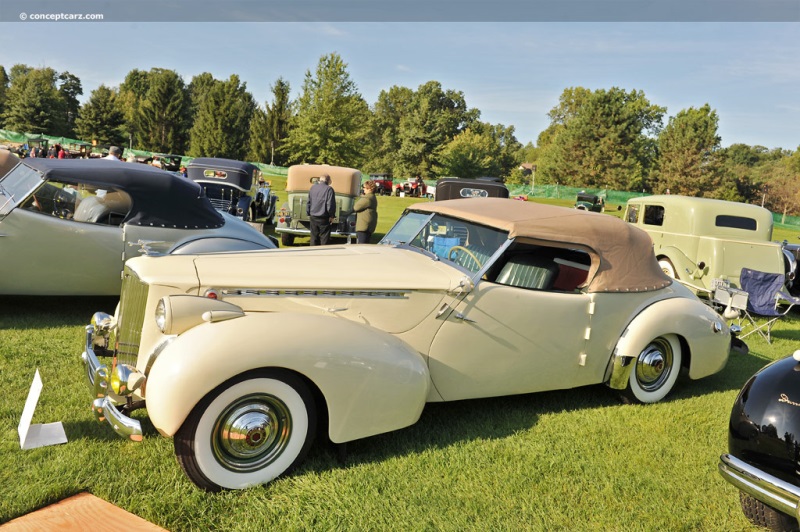The Packard was one of the finest American automobiles of the pre-war era and was always built to the highest standards. James Ward Packard was dissatisfied with his Winton motor carriage which is said to have spurred Mr. Packard into building a superior automobile. Along with his brother and two defectors from the Winton company, Packard used his electrical engineering factory in Warren, Ohio to build the first Packard, emerging in November of 1899. Its super build quality and innovative engineering caught the attention of wealthy clients, including William D. Rockefeller who purchased two at the New York Automobile Show in November 1900. The company soon adopted the advertising slogan, 'Ask The Man Who Owns One.' Packard quickly became positioned among the world's top luxury automobile manufacturers, was a frequent sight at the most exclusive society functions of its era, and was favored by film stars, plutocrats, and celebrities. Throughout the 1910s and 1920s, Packard ranked alongside Pierce-Arrow and Peerless, known throughout the U.S. automobile industry as the 'Three P's.' 
Convertible Coupe
View info and historyThe single-cylinder motorcar was soon joined by two-, four- and six-cylinder models before Packard became the first manufacturer to introduce a series production V12 with the launch of the Twin Six in 1916. The Eight followed in 1924 and was the first Packard to employ four-wheel brakes. The side-valve, straight-eight-cylinder engine displaced 5.9 liters and developed 85 horsepower. Packard's Eight models were initially comprised of ten body styles on two-wheelbase lengths.In 1927, the eight-cylinder engine was enlarged to 6.3 liters and a smaller 5.2-liter Standard Eight was introduced in 1929. The larger engine powered the Custom and DeLuxe Eights, and in 1933 the 'DeLuxe' was renamed 'Super Eight.' The stock market crash and the onset of the Great Depression in the late 1920s and early 1930s affected the entire automotive industry and sales plummeted across the board. The hardest-hit segment was the luxury car market as fewer buyers were able to indulge in such luxuries and those that could felt it in poor taste to flaunt their prosperity in the face of so much financial devastation. 
Convertible Coupe
View info and historyIn hopes of catering to a wider audience, Packard introduced the 'One Twenty' Eight for the 1935 season, also known as the 'Junior Packard.' This was the company's first foray into the medium-priced market sector, with styling, quality, and craftsmanship on par with the 'Senior' Packards but at a more 'affordable' price. The strategy worked and the Packard One-Twenty saved the company from the ill-fated demise that had claimed so many others. 24,995 examples of the One-Twenty were produced in its inaugural year compared to approximately 7,000 of all other Packards combined. Body styles on the One-Twenty included a club coupe, convertible, and four-door sedans all equipped with an all-new Packard aluminum head, L-head inline eight delivering 110 horsepower at 3,850 RPM. The three-passenger business coupe listed for $980 and the Touring Sedan sold for $1,095. The One-Twenty used a new independent front suspension system called the 'Safe-T-Flex' that used an unequal upper and lower A-arm type, with the largest lower A-arms using two different arms bolted together at a ninety-degree angle. The upper A-arm was welded and positioned parallel to the lower one and was responsible for controlling the camber. A support arm of heavy steel forging was designed to carry the load. The tubular, steel torque arm was bolted to the support arm and carried the decelerating and accelerating torque. 
Convertible Coupe
View info and historyPackard increased the displacement of the eight-cylinder engine for 1936 resulting in an increase in output to 120 bhp. A convertible four-door sedan body style joined the lineup and with a price of $1,395, making it more expensive than the other body styles. 1936 would be the most successful year for the One-Twenty, with 55,042 examples built.Packard moved the One-Twenty farther up-market in 1937 to make room for the Packard Six, the first six-cylinder Packard in a decade. The One-Twenty gained 'C' and 'CD' trim levels, and a wood-bodied station wagon built on a 138-inch wheelbase, along with a limousine and touring sedan. The 'd' in CD represented 'deluxe' and added a higher level of interior appointments including nicer trim, full Marshall springs in the seats, sponge-backed carpets, a banjo spoke steering wheel, and a clock, plus a radiator ornament and automatic radiator shutters. Series production reached 50,100 units for the Fifteenth Series 1937 Packard.To make the naming scheme consistent, the One-Twenty name was discontinued in 1938 and its body styles became part of the Packard Eight, resting above the Packard Six and below the Packard Super Eight. 1939 Packard One Twenty
After a brief absence, the One Twenty name reappeared in 1939 as part of the Seventeenth Series Packard, again representing the Junior eight-cylinder model. The engine received a new 6.40:1 compression ratio with 6.85:1 being optional, and the prior aluminum cylinder head was replaced by cast iron. The column-mounted gearshift, known as the Handishift, of the Packard Six was standard on the One Twenty, and the Econo-Drive (overdrive), No-Rol, and tachometer were optional. The No-Rol feature kept the car from rolling during starts on an incline.
Convertible by Darrin
Chassis #: B319346A
View info and history
Auction entries : 4With a diverse lineup of six- and eight-cylinder engines, numerous body styles, and several different platforms, customers had many options for 1939, and as such, sales of the One Twenty slipped to 17,647 units. Packard sold 24,350 examples of the Six, 3,962 of the Super Eight, and 446 of the Twelve (the final year of the Packard Twelve).Howard 'Dutch' Darrin
Howard 'Dutch' Darrin worked as a coachbuilder in Paris before settling in Hollywood, California, where he quickly established himself as the purveyor of custom coachwork to the stars. His first commission was a Ford roadster, followed by a two-passenger roadster built on a 1937 Packard One Twenty chassis for actor Dick Powell. The stunning coachwork was highly admired, eventually evolving into a four-passenger sedan with the same long hood, short rear deck, 'dipped' doors, and vee'd windshield. Among the list of prominent Hollywood stars who commissioned examples to include Clark Gable, Gene Krupa, and Preston Foster.Darrin's talent and his vast Rolodex of influential individuals drew the attention of Packard, which eventually acquired rights to the design and built the 'Convertible Victoria by Darrin,' in small numbers, as part of its own cataloged offerings, between 1940 and 1942. Packards built prior to 1940 are known as 'Hollywood Darrins,' each of which was handmade on Sunset Boulevard and each of which could genuinely be called unique. Although the exact figure is not known, it is estimated that approximately 30 examples were built, with around eight or nine (some sources state as high as 12) Convertible Victorias built in 1939 on both One Twenty and the larger Super Eight chassis. One of the 1939 'Hollywood' cars wore 1940-style rear fenders from new. It is also believed that five examples were built in 1941 with one for Errol Flynn.1940 and 1941 Packard One-Twenty
The One-Twenty officially became hyphenated for the 1940 model year and gained a tall radiator grille with two vertical side grilles on either side. The sealed beam headlights were installed on the fenders, with parking lights mounted on the fender crowns. A longer hood gave additional room for mounting of the optional spare wheels. The long-wheelbase chassis was no longer offered, leaving the 127-inch platform to carry to the thirteen body styles, including the Convertible Victoria by Darrin. Several of those body styles were removed from the One-Twenty line in 1941 and moved to the One-Ten. 28,137 examples were built of the Eighteenth Series 1940 Packard One-Twenty and 17,100 units the following year.
Convertible by Darrin
View info and historyThe Packard One-Twenty did not appear in 1942, and its body styles were folded into the Packard Six and Packard Eight lines. The total production during the One-Twenty's seven-year production lifespan, a total of 175,027 units were built. The Packard One-Twenty was influential in providing Packard with a much-needed influx of financial resources during the difficult years of the Great Depression. Some argue that it was partly responsible for the company's eventual demise, as it diluted the Packard ultra-exclusive name. While other great names like Pierce-Arrow, Marmon, Stutz, and Duesenberg had ceased operation and had passed into history, Packard survived.
by Daniel Vaughan | Feb 2021
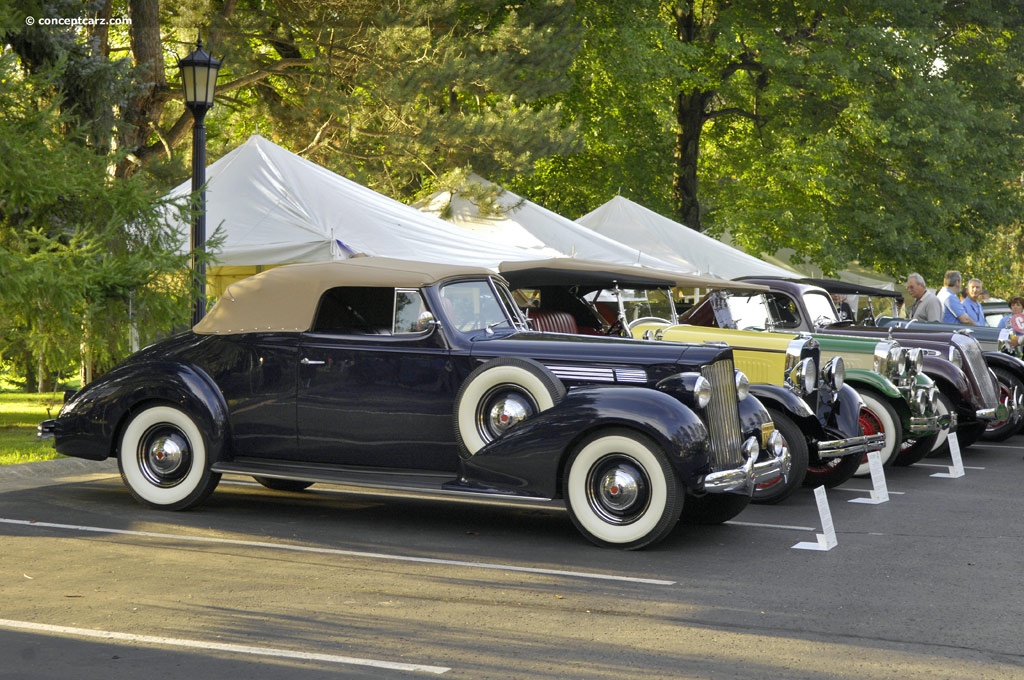
Convertible Coupe
View info and history
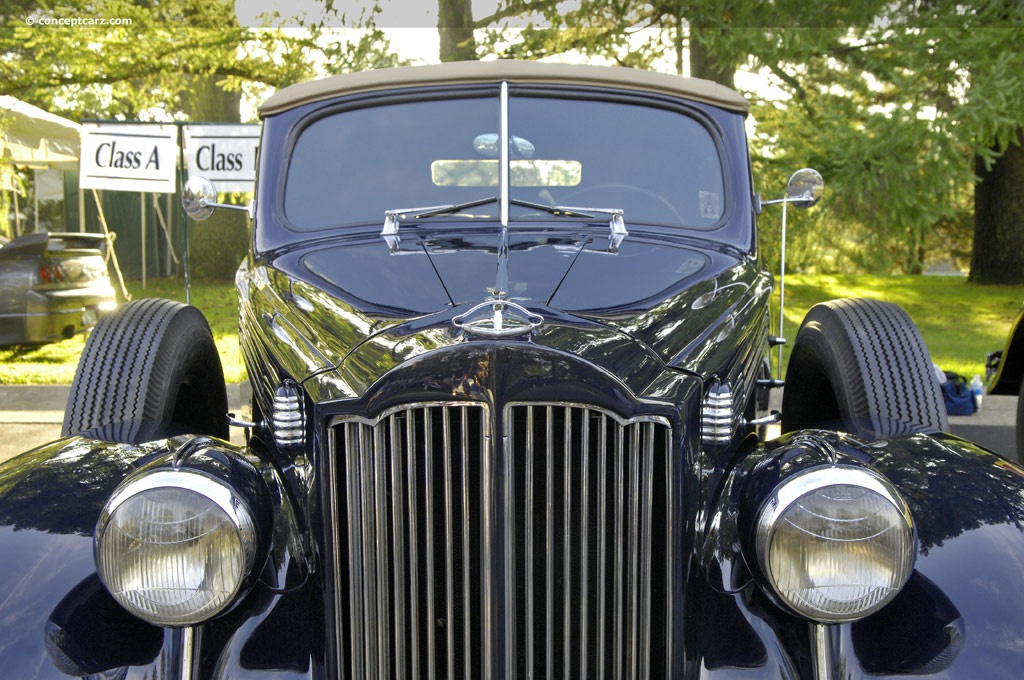
Convertible Coupe
View info and history
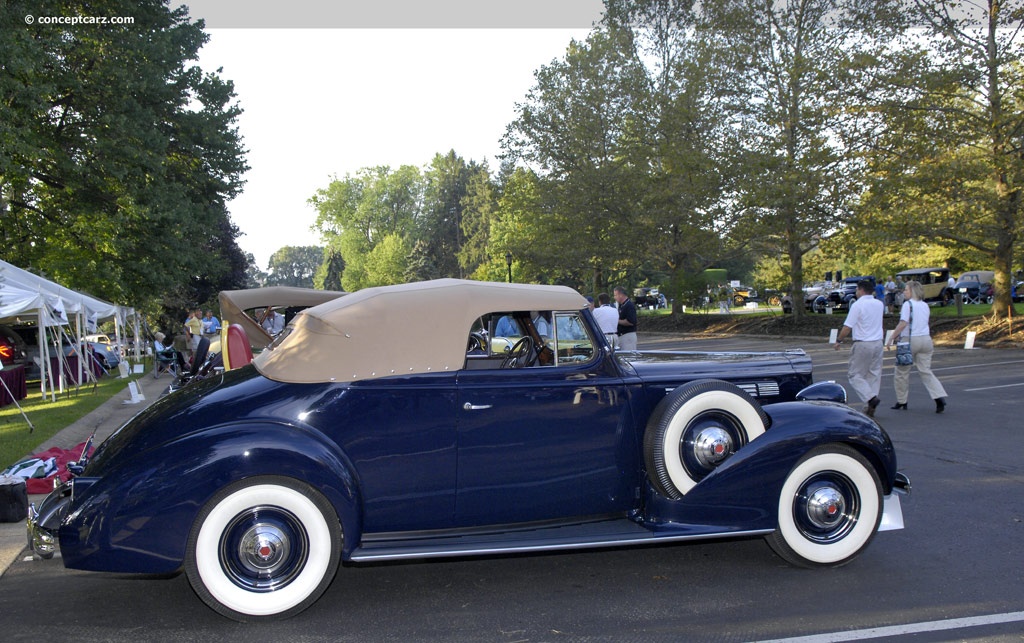
Convertible Coupe
View info and history
After a brief absence, the One Twenty name reappeared in 1939 as part of the Seventeenth Series Packard, again representing the Junior eight-cylinder model. The engine received a new 6.40:1 compression ratio with 6.85:1 being optional, and the prior aluminum cylinder head was replaced by cast iron. The column-mounted gearshift, known as the Handishift, of the Packard Six was standard on the One Twenty, and the Econo-Drive (overdrive), No-Rol, and tachometer were optional. The No-Rol feature kept the car from rolling during starts on an incline.
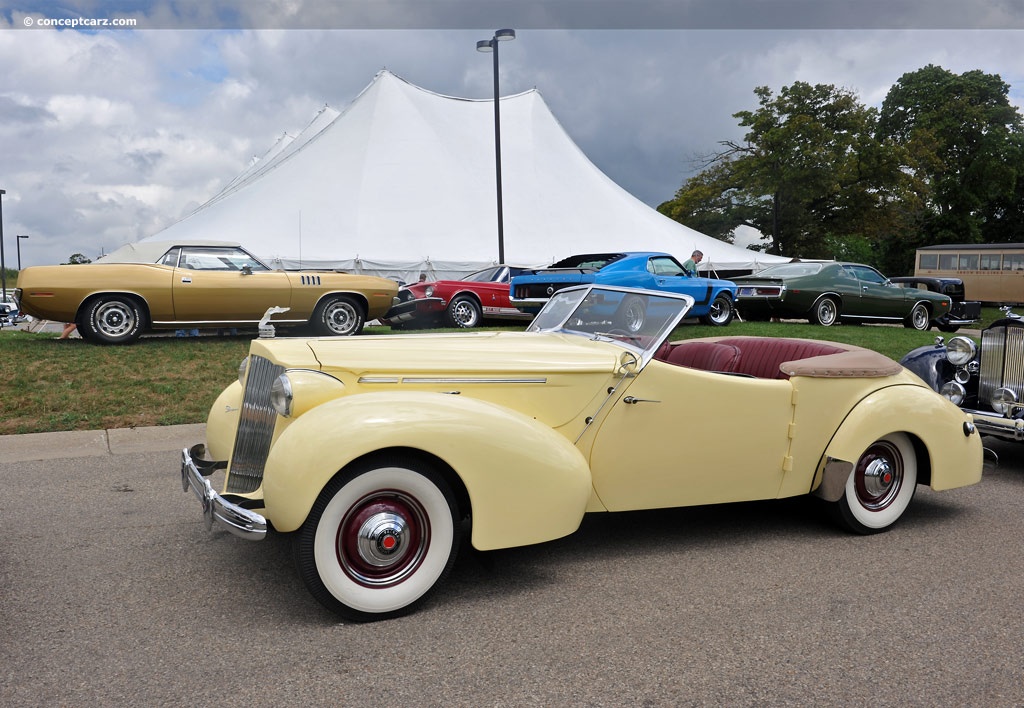
Convertible by Darrin
Chassis #: B319346A
View info and history
Auction entries : 4
Howard 'Dutch' Darrin worked as a coachbuilder in Paris before settling in Hollywood, California, where he quickly established himself as the purveyor of custom coachwork to the stars. His first commission was a Ford roadster, followed by a two-passenger roadster built on a 1937 Packard One Twenty chassis for actor Dick Powell. The stunning coachwork was highly admired, eventually evolving into a four-passenger sedan with the same long hood, short rear deck, 'dipped' doors, and vee'd windshield. Among the list of prominent Hollywood stars who commissioned examples to include Clark Gable, Gene Krupa, and Preston Foster.Darrin's talent and his vast Rolodex of influential individuals drew the attention of Packard, which eventually acquired rights to the design and built the 'Convertible Victoria by Darrin,' in small numbers, as part of its own cataloged offerings, between 1940 and 1942. Packards built prior to 1940 are known as 'Hollywood Darrins,' each of which was handmade on Sunset Boulevard and each of which could genuinely be called unique. Although the exact figure is not known, it is estimated that approximately 30 examples were built, with around eight or nine (some sources state as high as 12) Convertible Victorias built in 1939 on both One Twenty and the larger Super Eight chassis. One of the 1939 'Hollywood' cars wore 1940-style rear fenders from new. It is also believed that five examples were built in 1941 with one for Errol Flynn.1940 and 1941 Packard One-Twenty
The One-Twenty officially became hyphenated for the 1940 model year and gained a tall radiator grille with two vertical side grilles on either side. The sealed beam headlights were installed on the fenders, with parking lights mounted on the fender crowns. A longer hood gave additional room for mounting of the optional spare wheels. The long-wheelbase chassis was no longer offered, leaving the 127-inch platform to carry to the thirteen body styles, including the Convertible Victoria by Darrin. Several of those body styles were removed from the One-Twenty line in 1941 and moved to the One-Ten. 28,137 examples were built of the Eighteenth Series 1940 Packard One-Twenty and 17,100 units the following year.
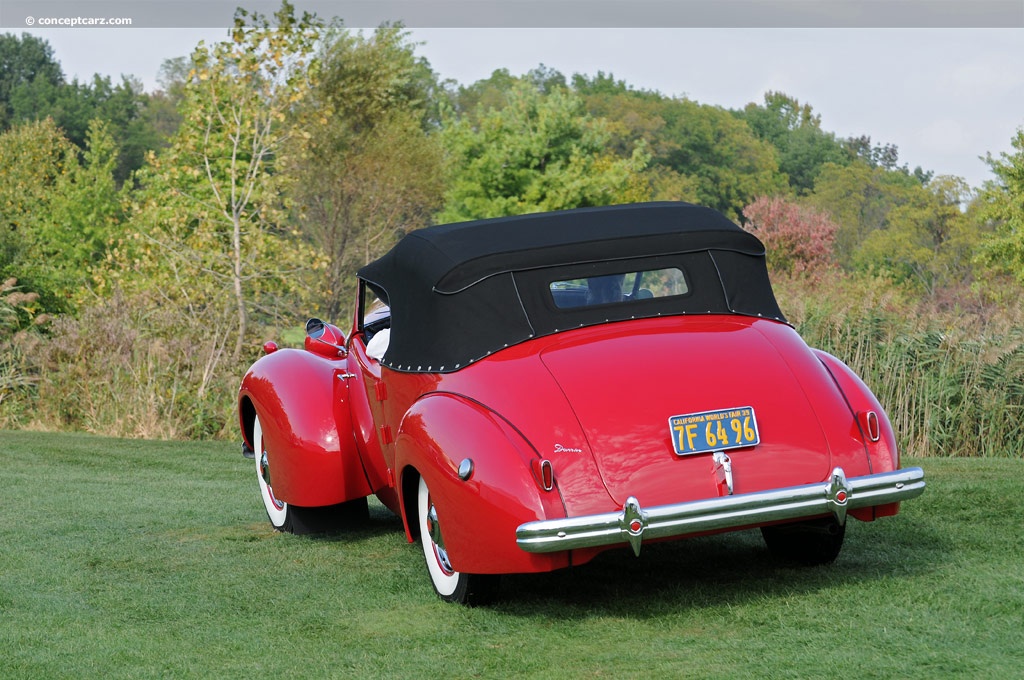
Convertible by Darrin
View info and history
by Daniel Vaughan | Feb 2021
Related Reading : Packard One-Twenty History
The Packard One-Twenty was produced from 1935 through 1937 and again from 1939 through 1941. The One-Twenty signified Packards move into the mid-priced eight-cylinder market a highly competitive segment that was filled with many marques with numerous offerings, options, and price ranges. The move had been made due to financial reasons and the need to stay competitive the Great Depression was taking....
Continue Reading >>
Continue Reading >>
Similar Automakers
Similarly Priced Vehicles
1939 Packard One Twenty Vehicle Profiles
Recent Vehicle Additions
Performance and Specification Comparison
Price Comparison
$890 - $1,400
$1,650 - $2,130
$2,200 - $2,300
$4,140 - $6,730
$4,500 - $8,400
One-Twenty Specification Comparison by Year
Year
Production
Wheelbase
Engine
Prices
Related Automotive News

Gooding & Company is Honored to Present a One-off Supercharged Mercedes-Benz
High-Style Highlights Include The 1928 Mercedes-Benz Type S 26180 Sports Tourer for Sale for the First Time in 53 Years, The 1939 Bugatti Type 57C Cabriolet with the Final Type 57 Chassis Number, The 1937 Maserati 6CM Formerly the Property of Racer...

RAM TRUCK TO SHOWCASE OFF-ROAD TRUCK LEADERSHIP AT 2016 OVERLAND EXPO
Overland Expo to host Ram Truck press conference and owner clinic
Fresh off their Chicago Auto Show unveiling, new 2017 Ram Power Wagon and Ram 2500 4x4 Off-road pickups will make their first Arizona appearance at the Overland Expo in Mormon Lake,...

BEST-OF-CATEGORY AUTOMOBILES DRIVE RM SOTHEBY'S $38.6 MILLION AMELIA ISLAND CONCOURS D'ELEGANCE SALE
RM Sothebys generates %2438.6 million in sales with 89 percent of all lots sold at its 18th anniversary Amelia Island, Florida sale
Top seller 1962 Ferrari 400 Superamerica LWB Coupe Aerodinamico surpasses estimate at %244,400,000 to set new auctio...
HILTON HEAD ISLAND MOTORING FESTIVAL & CONCOURS D'ELEGANCE PRESENTS 2015 PINNACLE AND HONORED COLLECTORS
Fred Guyton collection to feature 2014 Pebble Beach Concours Best in Class winner
William Tom Gerrard recognized for Post-War collection and key Concours contributions
HILTON HEAD ISLAND, S.C. – Each year, the Hilton Head Isla...

Magnificent Series of Coachbuilt Classics To Grace RM's Amelia Island Concours D'Elegance Sale
RM Auctions returns as the official auction house of the Amelia Island Concours dElegance, March 9, 2013
Single-day sale features breathtaking roster of more than 80 investment-quality collector cars
Notable highlights include an outstanding s...

























